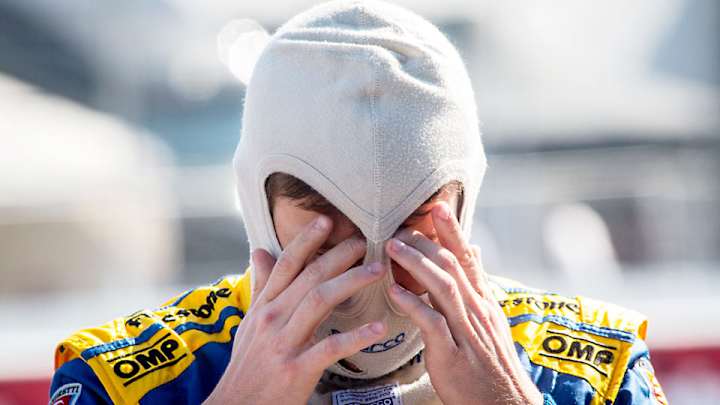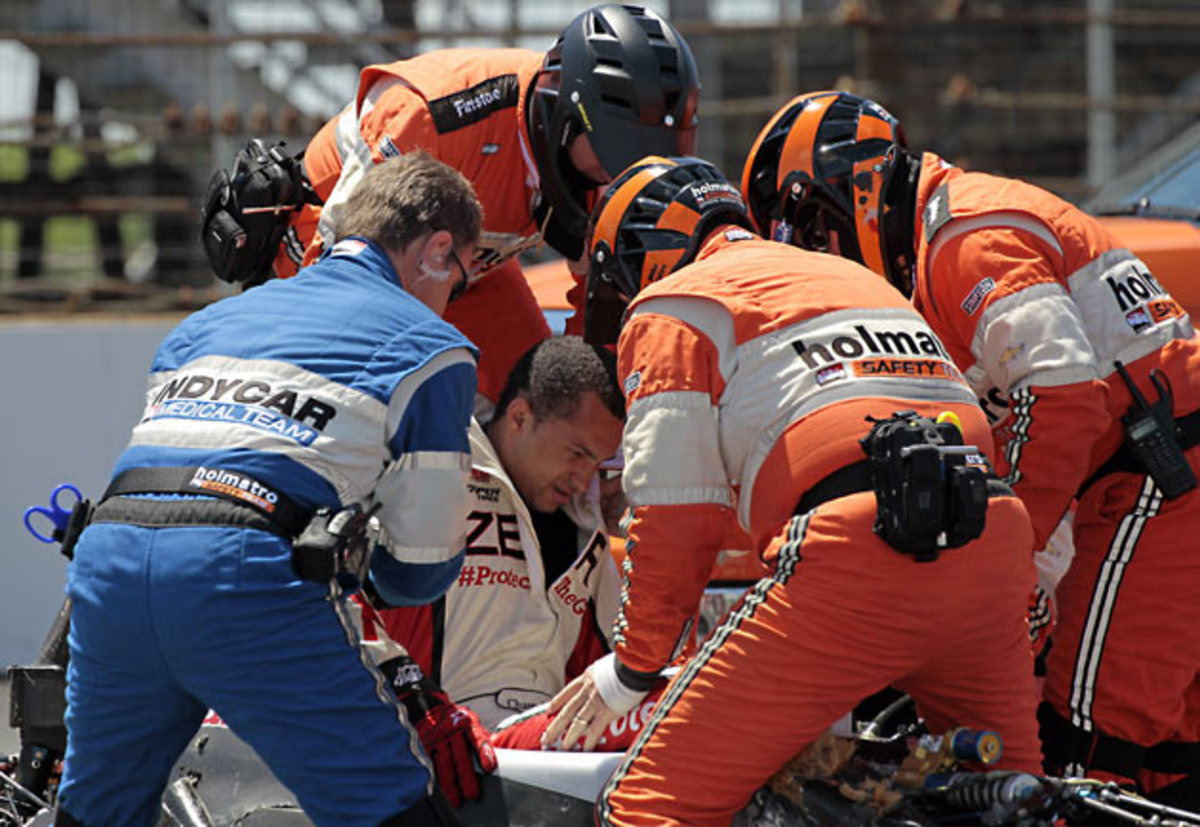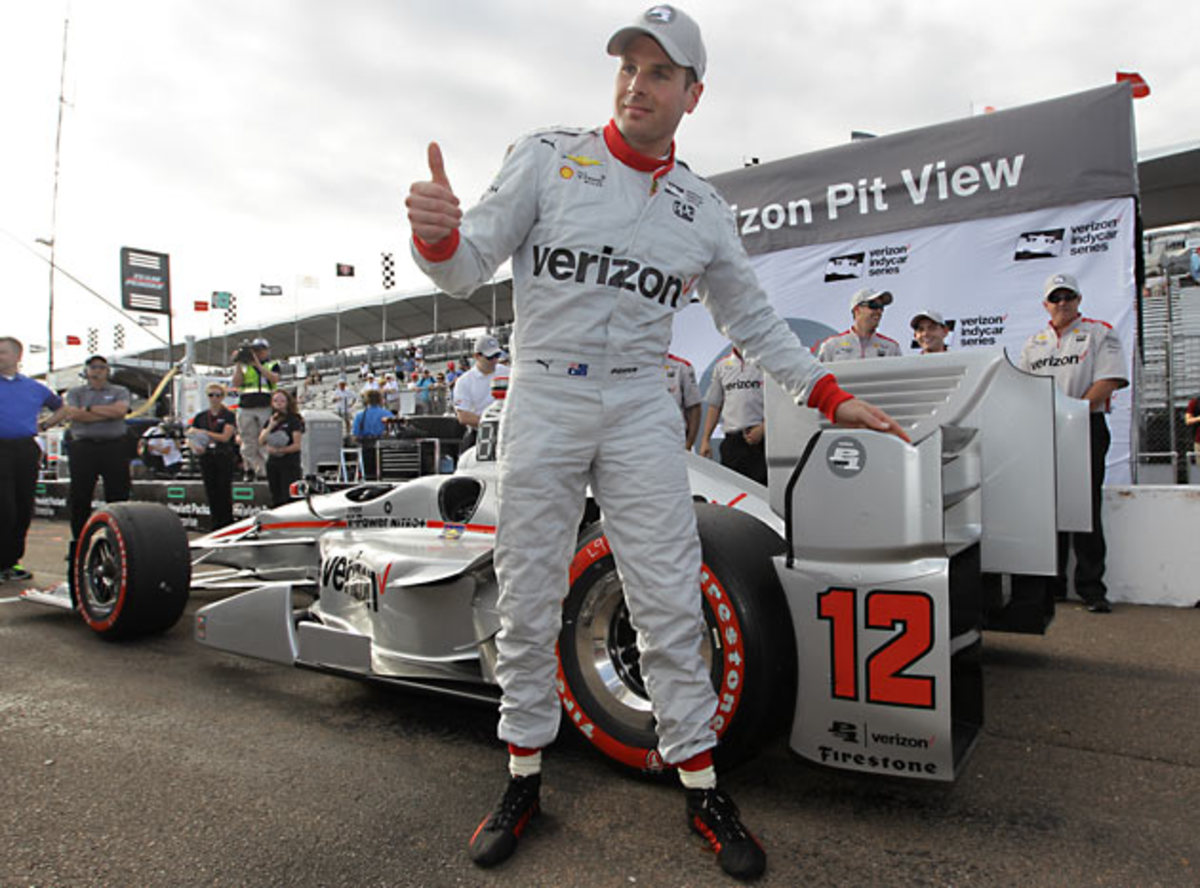IndyCar steadily coming to grips with concussions

Get all of Andrew Lawrence’s columns as soon as they’re published. Download the new Sports Illustrated app (iOS or Android) and personalize your experience by following your favorite teams and SI writers.
Two days before IndyCar’s March 13 kickoff race on the streets of St. Petersburg, Fla., Will Power set off in his silver Team Penske machine for a morning practice session. This was a fairly routine exercise, an occasion for drivers to reacclimatize themselves with St. Pete’s 1.8-mile, 14-turn circuit and race cars that had undergone some tweaking for the 2016 season.
Likewise, Power’s early laps were typical: quick, crisp—just the sort of clinical display that has become the 35-year-old’s calling card for a plurality of his 10 seasons as an American open-wheel racer. But then midway through one lap, as Power was fettling his No. 12 Chevy from the cockpit, he under-steered going left into Turn 9, smacked sideways into a barrier on the right and slid the length of the ensuing straightaway before coming to rest near a runoff area by Turn 10.
On the spectrum of IndyCar crashes, this was mild fare—nothing like the violence that can result on ovals, where speeds are much higher. The Penske Chevy, with its caved-in right side, appeared to be in far worse shape than Power—who after a medical clearance simply hopped out of that car and into a backup. The next day he smashed his own track record three times while capturing the pole.
Will Power misdiagnosed with concussion before IndyCar opener
So it was shaping up to be a healthy weekend for the Aussie, a frequent pole sitter (36 times and counting) who was on pace to repeat as series champion in 2015 until a so-so fourth quarter—at Fontana (where he finished 19th), Milwaukee (22nd) and Mid-Ohio (14th)—complicated his chances. Not even Power’s Penske colleagues truly knew how terrible he felt on the day he qualified at St. Pete: He was headachy, stiff-necked, nauseous, dizzy, congested—and that was before his blistering road trip. So wiped out was Power, in fact, that he was second-guessing his decision to suit up and drive well past the point of buckling in.
By the end of it he was almost literally buckling. After giving a somewhat scatterbrained post-qualifying TV interview, the typically media friendly Power apologetically asked out of an obligatory news conference, citing wooziness. When word of Power’s symptoms reached St. Pete race director Brian Barnhart, another medical evaluation was arranged for the stricken driver. Team Penske, bracing for the worst, hustled to produce a substitute pilot—the ever-ready Oriol Servià. On race day the long-feared bad news finally arrived. Geoffrey Billows, in his capacity as IndyCar’s medical director, scratched Power from the race. His diagnosis, initially? A concussion. It was an instructive moment.

There’s no doubt that popular awareness of concussions has risen dramatically over the past decade. Football and hockey, the sports where shelled bodies collide, pose the greatest threats to intellect—or so goes the thinking. Rarely are concussions associated with car crashes even though the Centers for Disease Control has them ranked third on its list of leading traumatic brain injury sources, behind unintentional blunt-force trauma (which, incidentally, also occurs in car crashes) and falling.
That disconnect in concussion perception, between stick-and-ball sports and racing, might be because a racer—between his Hans device, the “soft” track walls and that carbon fiber shell he calls an office—seems so well protected. Or it could be because getting your bell rung is the least of his concerns. Recall: This is a sport where people die in competition. (The uniform is a firesuit, for chrissakes.) Remember: it’s only been six months since a driver perished during a race.
NFL’s admission of likely CTE link raises heat on NHL
Racing is not like, say, pro football, where the real risks of head trauma weren’t made explicit until, like, five minutes ago. Here, the dangers are clear and ever present. Every driver approaches them differently. “Some guys sit in the car and say, This can never happen to me,” Gil de Ferran, a 2003 Indy 500 winner, told SI Now in an interview last year. “Other drivers take a completely different tack. I personally knew every time I put my helmet on and fastened my seat belts and went out there, I knew … perhaps I wouldn’t come back. I’ve seen too many things. I’ve seen several of my colleagues get severely injured. I’ve seen some pass away, unfortunately, right in front of my eyes. So how could I say, This will never happen to me? That was not logical.”
Fifteen years ago de Ferran was Power, a foreign-born (Brazil, in his case) Penske pilot who regularly challenged for championships. De Ferran also suffered his share of big bangs behind the wheel. Three in particular he remembers really messing with his head. The first, back in Europe in 1991, came after his car had tumbled end-over-end. “For a couple weeks I couldn’t see anything, and that was not very nice. Eventually my eyesight came back to normal. I was sleeping like 20 hours a day, 18 hours a day. The brain is a funny thing.”
The two other memorable hits he took in IndyCar. They shook him up in a different way. “When you have a head injury, it’s a really scary thing psychologically,” de Ferran said. “You’re smart enough to know that you’re not normal. You’re aware enough to know that your memory’s not right, that your logic processing is not right. (…) It’s almost like being a little drunk.”
This is why IndyCar now does not hesitate to step in if a driver seems even the slightest bit off. Think about it: If the doctors don’t act, a driver might not react, and all that idling could spell disaster on the track. In a conference call with reporters on Wednesday, Stephen Olvey, a neurocritical care physician who treated Power, said: “Twelve to fifteen years ago we used to say that if a driver had a particularly bad crash and maybe he was unconscious for a minute or two and then felt fine or it was getting better, we’d say, ‘Oh, good. He just had a concussion. Well as you all know now, we understand that a concussion is very serious. Too many concussions can be really bad, and too many too soon can lead to CTE and all that stuff everyone has read about in papers.”
The SI Extra Newsletter Get the best of Sports Illustrated delivered right to your inbox
Subscribe
A baseline neurocognitive assessment has been part of IndyCar’s concussion protocol ever since, along with SCAT testing after the fact. Data are collected through devices on the car and through ear bud sensors called accelerometers, which sit deep in the ear canal to measure the G-force impact on the head. If anything appears amiss, IndyCar will park a driver for a week or longer.
Concerns rise sharply after an impact of more than 80g, according to Terry Trammell the longtime IndyCar safety consultant whose specialty is in orthopedics. He’s also quite skilled—well, maybe aggressive is a better word—at following up with drivers after crashes in person and/or remotely, “by the drivers’ preferred method of communication called text messaging,” he cracks. In IndyCar’s modest population, which includes a medical staff that travels with the rest of the circus, Trammell can actually get to know drivers and establish a pretty solid anecdotal baseline for health.
So IndyCar would appear to have a well-oiled system for identifying concussed racers and administering care. But it’s not without its blind spots. Drivers are still free to make for the airport right after crashing out of a road course race. Compare that with oval events, where drivers are penned inside the infield care center for at least 15 minutes of monitoring before they’re released back into the wild.
Also: The protocol hasn’t really trickled down to open-wheel’s minor league system, a fact Olvey himself pointed out on the conference call. “There’s still people [there] who think you have to be knocked out,” he says of concussion diagnostic procedures at these lower levels. There the drivers are bold, wreck-prone and have brains that are still developing. Jody Karam—father of Sage, an IndyCar rookie last year—says his 21-year-old son never received more than a physical during the eight years he spent working his way up to the triple-A racing ranks of Indy Lights.
But of course the largest vulnerability in the system, far and away, remains competitive spirit. Race drivers, whether self-motivated or under pressure (financial or otherwise) from a team, will go to pretty much any lengths to keep their seats. In NASCAR, which has a similar concussion protocol, Dale Earnhardt Jr. admitted to twice hiding concussion symptoms so he could stay in the car. This was after a pair of concussions in six weeks forced him into a two-week vacation.
What’s more, you don’t hear much about drivers complaining about long-term head injuries. Still, that’s not to say people don’t have their suspicions. Fred Lorenzen, the 1965 Daytona 500 winner, seems like a candidate for CTE. Dale Earnhardt Jr. plans on bequeathing his brain for concussion research. ("What use is it to you at that point?" he tweeted.) De Ferran, the Indy winner, isn’t sure if he’s moodier and more forgetful because he’s 48, or because his brain has been bruised one too many times.
Power? He’s had at least three documented concussions heading into this season. So you can imagine how relieved he was to later discover that the incident at St. Pete hadn’t given him a fourth one.

The IndyCar protocol, as it turns out, got his case wrong—though doctors suspected that might happen. Power’s accelerometer data returned a reading of around 30g at the time of impact— well below the concern threshold.
While his peers raced away on the following day and his Penske teammate Juan Pablo Montoya grabbed the checkered flag, Power submitted to an eight-hour checkup at the University of Miami Concussion Program. There he learned that what had looked for all the world like a concussion was really a bad inner ear infection made worse by seasonal allergies. “One of the things that nobody ever said a word about,” Trammell says, “is his motorhome was parked underneath a flowering tree that was in full bloom in Florida, and he’s deathly allergic to tree pollen. So he’s like, Oh by the way, I got up Saturday morning, my eyes were swollen shut. My neck was swelling up. Did he tell anybody that? No. Because, for him, that’s normal. So he took his allergy stuff and he went on. But this time the combination of things was more than his system could handle.”
Long term, Power seems like he’ll be OK. If anything still really smarts it’s that he scored just one point (for landing on pole) in the St. Pete race, which puts him far behind in the championship hunt. He sits 23rd heading into the next IndyCar race in Phoenix on April 2. Luckily for him there’s still plenty of season left. (He’s expected to be back in the car for a Tuesday test session at Barber Motorsports Park in Alabama.) And Power is further fortunate to have the full support of Team Penske—which, to its credit, did not force him into a Sophie’s choice between his health and his job. It’ll be interesting to see whether teams that aren’t as well funded as Penske also take this high road, and whether drivers who aren’t as well established as Power can afford to remain as patient while yielding to protocol.
No, the system didn’t get everything right. But it got the big things right while flagging possible areas of improvement. All the while nobody got hurt. In an ever-evolving process, that’s not such a bad outcome. “Safety’s a process,” de Ferran said. “Safety’s not a place where you arrive and you say, ‘Oh. I’m safe!’ Because let’s face it: there’s an inherent risk in our sport that will never go away. However, it’s the duty of everyone involved to, every time, make a little step.”
